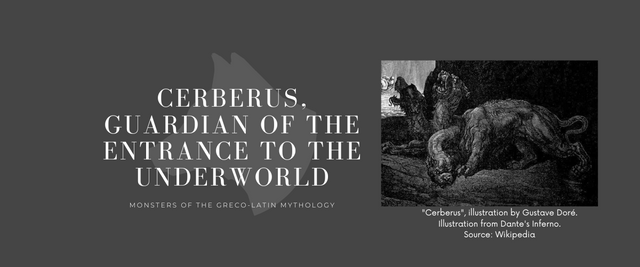Monsters of the Greco-Latin Mythology: Cerberus, Guardian of the entrance to the Underworld
Author's note: The following articles was previously published in Spanish language on my Blurt blog in February 23rd, 2023.

In the previous entry, the character of Orthrus, a two-headed dog that protected the herds of the giant Gerión, was briefly explored. Orthrus was the son of Echidna and Typhon, and father of the Nemean Lion, the Sphinx of Thebes, and the Chimera; he was the brother of other monstrous beings, among which stands out Cerberus, the guardian of the entrance to the Underworld.
Who was Cerberus?
Robert Graves (2007) explains that Cerberus was the second son of Typhon and Echidna. As for his ancestry, he was a grandson of the primordial divinities Gaia and Tartarus on the paternal side; at the same time, he was a grandson of the sea god Phorcys and the monster Ceto on his mother's side.
Hades took him to the kingdom of the dead, where he entrusted him with the protection of the bank of the river Styx that adjoined the entrance to the Underworld; in this way, he procured to keep at bay the souls of the departed that tried to escape and the living intruders that tried to enter. If a soul escaped or a living being tried to infiltrate the realm of the dead, Cerberus devoured them.
Hesiod (2000) offers us a curious fact about his appearance: he describes him as a dog with fifty heads, a bronze voice, great ferocity and insatiable hunger. However, Felix Guirand (1970) points out that in later versions he's described as a three-headed dog, with a fur full of snakes and a snout containing black poison. This same author tells us that the deceased used to take honey and flour desserts with them to give it to him.
Cerberus and Heracles
On several occasions, Cerberus has interacted with different heroes, who have managed to appease him through cunning and wit. Carlos Gaytán (1965) gives us an example on Aeneas, who gives him a bouquet of gold, and Orpheus, who appeases him by playing a melody on his lyre. He also gives us an example on the god Hermes, who reassures him by showing him his Caduceus while he guided the souls to the banks of the river Styx, where the ferryman Charon was waiting for them.
However, Heracles was the only living being who chose to resort to force. He needed to complete the last job that Eurystheus, king of the Argolis, had commissioned him in order to redeem his guilt. Said work consisted of the fact that he had to force the dog to see the sunlight or, as Michael Köhlmeier (2007) pointed out, bring it before the presence of the king.
An interesting version of this myth summarized by Graves (1985) tells us that Heracles had to be initiated into the Eleusinian Mysteries before descending to the Underworld; having prohibited the participation of foreigners in the Greater Mysteries, which were celebrated in honor of Demeter and Persephone, the Eleusinians (or Demeter herself, according to other versions) decided to found the Lesser Mysteries, so that Heracles could fully fulfill his mission.
During his stay in the Underworld, he crossed the Styx River with Charon's help; this angered Hades, who punished Charon by chaining him for a year in the depths of the Underworld. He also immediately released Theseus and Ascalaphus, who had been punished for various reasons. The first had tried to kidnap Persephone, so Hades tied him to a magical seat along with Pirítoo, his accomplice (Cartwright, 2016); the second had betrayed Persephone to Zeus and Hermes, declaring that he had seen her eat a pomegranate seed, which is why Demeter punishes him by burying him under a stone.
He then fought Menetus, whom he almost killed if it weren't for the intervention of Persephone, the wife of Hades. In some versions of the myth compiled by Köhlmeier (2007), it's mentioned that before fighting Cerberus, Heracles faced Hades; the latter, defeated by the formidable strength of the hero and his skill, told him that he could take the dog only if he fought it without weapons and if he returned it to the realm of the dead at the end of his mission. Heracles agreed to his conditions and faced the dog, whom he subdued by taking it by the neck and then carrying it on his shoulders.
An interesting aspect that Graves (2007) points out to us about the forced ascent of Cerberus is the usefulness of this myth to explain the origin of poisonous plants, particularly aconite; this plant with blue petals and great beauty sprouted from the ground thanks to the dog's drool.
After a brief stay in the world of the living, Cerberus returned to the Underworld, where he resumed his duties as guardian of the entrance to Hades' realm.
Consulted sources
- Cartwright, Mark, y Chaidez, Ritchie R. R. (traductor). 2 de mayo de 2016. “Teseo”, en: World History Encyclopedia. Consultado el 22 de febrero de 2023. English version: Theseus.
- Gaytán, Carlos. 1965. Diccionario mitológico. México, D.F. Editorial Diana.
- Graves, Robert. 2007. Los Mitos Griegos, vol. I. México. Alianza Editorial – Colección Religión y Mitología. English version: The Greek Myths: The complete and definitive edition.
- Graves, Robert. 1985. Los Mitos Griegos, vol. II. México. Alianza Editorial. (See English version in the previous bibliography).
- Guirand, Félix. 1970. New Larrouse Encyclopedia of Mythology. Introduction by Robert Graves. Inglaterra. The Hamlyn Publishing Group Limited.
- Hesíodo. 2000. Teogonía. Trabajos y días. Escudo. Certamen. México. Alianza Editorial. English version: Theogony and Works and Days [Oxford's World Classics]
- Köhlmeier, Michael. 2007. Breviario de mitología clásica. Vol. II. España. Edhasa – Los libros de Sísifo.
- S/f. “Ascálafo (hijo de Aqueronte)”, en: Wikipedia. Consultado el 22 de febrero de 2023. English version: Ascalaphus (Son of Acheron).
:: Banner made with Canva. Source of the image: Wikipedia ::